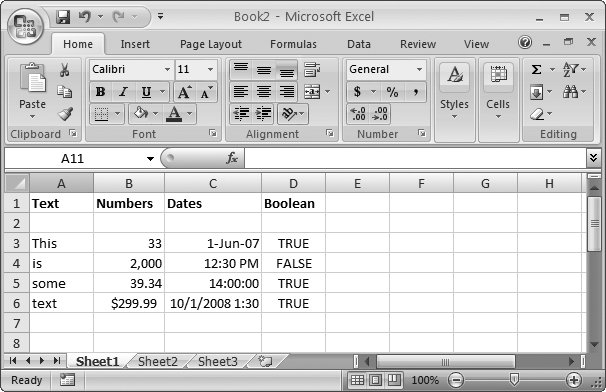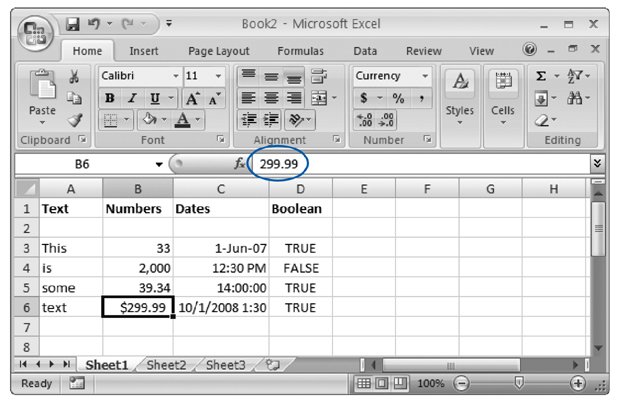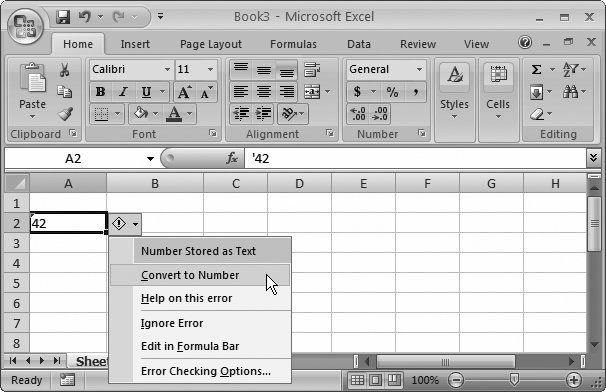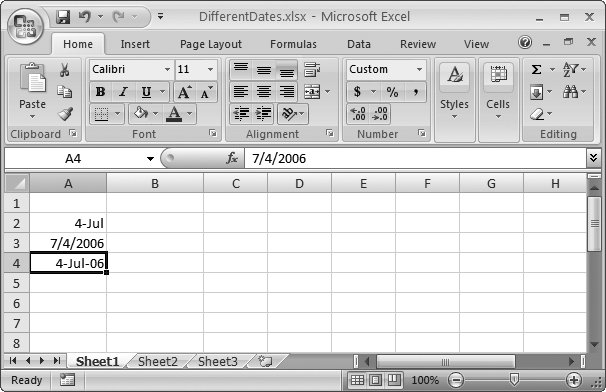Section 2.1. Adding Different Types of Data
2.1. Adding Different Types of DataOne of Excel's most important features is its ability to distinguish between different types of information. A typical worksheet contains both text and numbers. There isn't a lot you can do in Excel with ordinary text (other than alphabetize a list, perform a simple spell check, and apply some basic formatting). On the other hand, Excel gives you a wide range of options for numeric data. For example, you can string your numbers together into complex calculations and formulas, or you can graph them on a chart. Programs that don't try to separate text and numberslike Microsoft Word, for examplecan't provide these features. Most of the time, when you enter information in Excel, you don't explicitly indicate the type of data. Instead, Excel examines the information you've typed in, and, based on your formatting and other clues, classifies it automatically. Excel distinguishes between four core data types:
One useful way to tell how Excel is interpreting your data is to look at cell alignment, as explained in Figure 2-1.
Note: The standard alignment of text and numbers doesn't just represent the whims of Excelit also matches the behavior you want most of the time. For example, when you type in text, you usually want to start at the left edge so that subsequent entries in a column line up. But when entering numbers, you usually want them to line up on the decimal point so that it's easier to scan a list of numbers and quickly spot small and large values. Of course, if you don't like Excel's standard formatting, you're free to change it, as you'll see in Chapter 5. As Figure 2-1 shows, Excel can display numbers and dates in several different ways. For example, some of the numbers include decimal places, one uses a comma, and one has a currency symbol. Similarly, one of the time values uses the 12-hour clock while another uses the 24- hour clock. Other entries include only date information or both date and time information. You might assume that when you type in a number, it will appear in the cell exactly the way you typed it. For example, when you type 3-comma-0-0-0 you expect to see 3,000. However, that doesn't always happen. To see the problem in action, try typing 3,000 in a cell. It shows up exactly the way you entered it. Then, type over that value with 2000 . The new number appears as 2,000. Excel remembers your first entry, and assumes that you want to use thousand separators in this cell all the time . These differences may seem like a spreadsheet free-for-all, but don't despairyou can easily set the formatting of numbers and dates. (In fact, that's the subject of Chapter 5.) At this point, all you need to know is that the values Excel stores in each cell don't need to match exactly the values that it displays in each cell. For example, the number 4300 could be formatted as plain old 4300 or as the dollar amount $4,300. Excel lets you format your numbers so you have exactly the representation you want. At the same time, Excel treats all numbers equivalently, no matter how they're formatted, which lets you combine them together in calculations. Figure 2-2 shows you how to find the underlying stored value of a cell. Note: Excel assigns data types to each cell in your worksheet, and you can't mix more than one data type in the same cell. For example, when you type in 44 fat cats , Excel interprets the whole thing as text because it contains letters . If you want to treat 44 as a number (so that you can perform calculations with it, say), then you need to split this content into two cellsone that contains the number 44 and one that contains the remaining text. 2.1.1. Controlling Your Data TypesBy looking at cell alignment, you can easily tell how Excel is interpreting your data. That's helpful. But what happens when Excel's interpretation is at odds with your wishes? For example, what if you type in something you consider a number but Excel freakishly treats it as text , or vice versa? The first step to solving this problem is grasping the logic behind Excel's automatic decision-making process.
2.1.1.1. How Excel decides your data is textIf your cell meets any of the following criteria, Excel automatically treats the content as ordinary text:
Occasionally, Excel reads your data the wrong way. For example, you may have a valuelike a social security number or a credit card numberthat's made up entirely of numeric characters but that you want to treat like text because you don't ever want to perform calculations with it. But Excel doesn't know what you're up to, and so it automatically treats the value as a number. You can also run into problems when you precede text with the equal sign (which tells Excel that you have a formula in progress), or when you use a series of numbers and dashes that you don't intend to be part of a date (for example, you want to enter 1-2-3 but you don't want Excel to read it as January 2, 2003which is what it wants to do). In all these cases, the solution's simple. Before you type the cell value, start by typing an apostrophe ('). The apostrophe tells Excel to treat the cell content as text. Figure 2-3 shows you how it works.
When you precede a numeric value with an apostrophe, Excel checks out the cell to see what's going on. When Excel determines that it can represent the content as a number, it places a green triangle in the top left corner of the cell and gives you a few options for dealing with the cell, as shown in Figure 2-4. Note: When you type in either false or true (using any capitalization you like), Excel automatically recognizes the data type as Boolean value instead of text, converts it to the uppercase word FALSE or TRUE, and centers it in the cell. If you want to make a cell that contains false or true as text and not as Boolean data, start by typing an apostrophe (') at the beginning of the cell.
2.1.1.2. How Excel decides your data is numericExcel automatically interprets any cell that contains only numeric characters as a number. In addition, you can add the following non-numeric characters to a number without causing a problem:
The most important thing to understand about entering numbers is that when you choose to add other details like commas or the dollar sign, you're actually doing two things at once: you're entering a value for the cell and you're setting the format for the cell, which affects how Excel displays the cell. Chapter 5 provides more information about number styles and shows how you can completely control cell formatting. 2.1.1.3. How Excel decides your data is a date or timeWhen typing in a date, you have a choice of formats. You can type in a full date (like July 4, 2007 ) or you can type in an abbreviated date using dashes or slashes (like 7-4-2007 or 7/4/2007 ), which is generally easier. If you enter some numbers formatted as a date, but the date you entered doesn't exist (like the 30th day in February or the 13th month), then Excel interprets it as text. Figure 2-5 shows you the options.
Because you can represent dates a few different ways, working with them can be tricky, and you're likely to encounter some unexpected behavior from Excel. Here are some tips for using dates, trouble-free:
Note: The way Excel recognizes and displays dates varies according to the regional settings on your computer, but the way Excel stores dates does not. This feature comes in handy when you save a worksheet on one computer and then open it on another computer with different regional settings. Because Excel stores every date the same way, the date information remains accurate on the new computer, and Excel can display it according to the new regional settings. Typing in times is more straightforward than typing in dates. You simply use numbers, separated by a colon (:). You need to include an hour and minute component at minimum (as in 7:30), but you can also add seconds, milliseconds , and more (as in 7:30:10.10). You can use values from 1 to 24 for the hour part, though if your system is set to use a 12-hour clock, Excel converts the time accordingly (in other words, 19:30 becomes 7:30 PM). If you want to use the 12-hour clock when you type in a time, follow your time with a space and the letters P or PM (or A or AM). Finally, you can create cells that have both date and time information. To do so, just type the date portion first, followed by a space, and then the time portion. For example, Excel happily accepts this combo: 7/4/2008 1:30 PM. Behind the scenes, Excel stores dates as serial numbers . It considers the date January 1, 1900 to be day 1. January 2, 1900 is day 2, and so on, up through the year 9999. This system is quite nifty because if you use Excel to subtract one date from another, then you actually end up calculating the difference in days, which is exactly what you want. On the other hand, it means you can't enter a date in Excel that's earlier than January 1, 1900 (if you do, Excel treats your date like text). Similarly, Excel stores times as fractional numbers from 0 to 1. The number 0 represents 12:00 a.m. (the start of the day) and 0.999 represents 11:59:59 p.m. (the end of the day). As with dates, this system allows you to subtract one time value from another. |
EAN: N/A
Pages: 75




